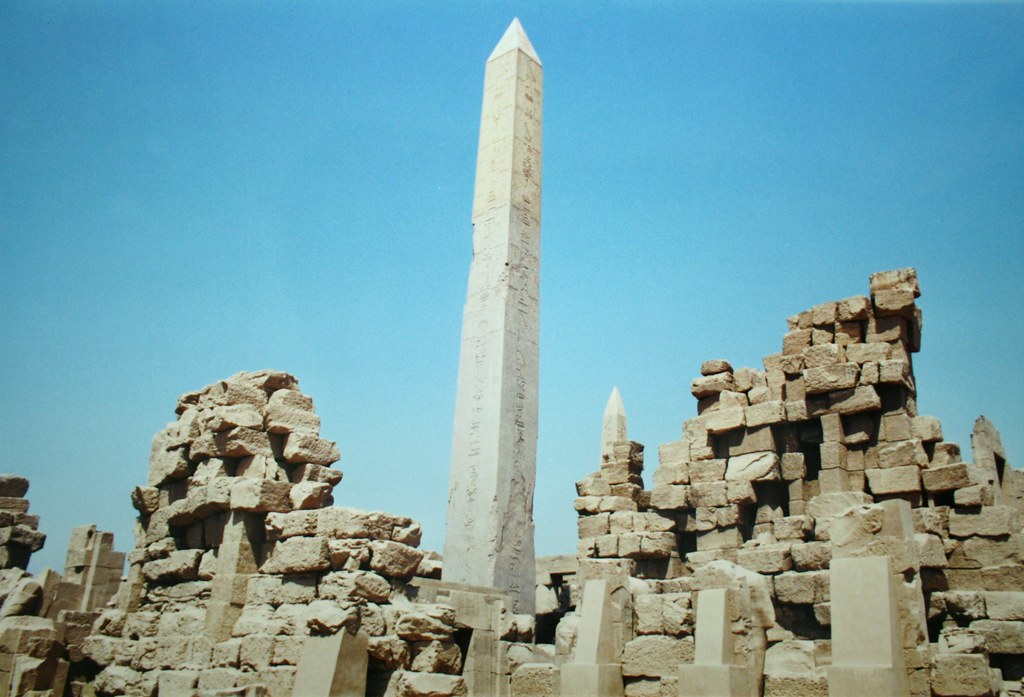
Gazing skyward from the heart of Karnak Temple, the remaining obelisk of Hatshepsut stands as a silent yet powerful testament to the ambition, ingenuity, and artistry of one of ancient Egypt’s most remarkable pharaohs. More than just a monolithic shaft of stone, this towering structure is a tangible link to a golden age, whispering tales of a female ruler who dared to assume the full power of the Egyptian throne and left an indelible mark on its landscape. To truly appreciate the majesty of Hatshepsut’s obelisk is to delve into the intricate tapestry of her reign, the religious significance of these solar symbols, the remarkable feat of their creation, and the enduring legacy they represent.
Hatshepsut, meaning “Foremost of Noble Ladies,” rose to prominence during the Eighteenth Dynasty, a period of immense prosperity and cultural flourishing. Initially serving as regent for her stepson Thutmose III, she gradually consolidated her power, eventually adopting the full titulary and regalia of a pharaoh. Her reign, lasting approximately two decades, was characterized by ambitious building projects, peaceful trade expeditions, and a deliberate effort to legitimize her unprecedented rule. Among her most significant undertakings was the expansion and embellishment of the Karnak Temple complex in Thebes (modern-day Luxor), the grandest religious site in Egypt.
It was within these sacred precincts that Hatshepsut erected several pairs of magnificent obelisks. These elegant, tapering pillars, typically carved from a single piece of granite, were deeply symbolic, representing the sun’s rays descending to earth. Their association with the sun god Ra, the supreme deity of the Egyptian pantheon, imbued them with immense religious significance. Obelisks were not merely decorative; they were potent symbols of royal power, cosmic order, and the pharaoh’s vital connection to the divine.
The creation of Hatshepsut’s obelisks was a monumental undertaking, a testament to the advanced engineering and organizational capabilities of ancient Egyptian society. The preferred material was often the rose-colored granite quarried in Aswan, hundreds of kilometers south of Thebes. Imagine the sheer scale of the operation: skilled quarrymen meticulously extracting massive blocks of stone, carefully working around any natural flaws. Once freed, these colossal monoliths, some weighing hundreds of tons, had to be transported down the Nile River on specially constructed barges. This journey alone would have been fraught with challenges, requiring precise navigation and a vast workforce.
Upon arrival at Karnak, the task of erecting these towering shafts was equally daunting. While the exact methods remain a subject of scholarly debate, it is believed that a combination of ramps, levers, ropes, and sheer manpower was employed to carefully raise the obelisks into their vertical positions. The precision with which these massive stones were placed, often fitting perfectly into prepared pedestals, speaks volumes about the architectural prowess of the ancient Egyptians.
Hatshepsut’s obelisks were not left unadorned. Their surfaces were meticulously carved with intricate hieroglyphic inscriptions. These texts served multiple purposes: they proclaimed the pharaoh’s name and titles, celebrated her divine legitimacy, documented her achievements, and dedicated the obelisks to the glory of Amun-Ra, the syncretic deity who rose to prominence during the New Kingdom. Examining these inscriptions today offers invaluable insights into the religious beliefs, political ideologies, and artistic conventions of Hatshepsut’s era.
One of the most striking aspects of Hatshepsut’s obelisks at Karnak was their sheer height. Historical accounts and surviving fragments suggest that some of these monoliths were among the tallest ever erected in Egypt. The towering presence of these gleaming shafts, piercing the skyline, would have undoubtedly inspired awe and reverence in the hearts of the ancient Egyptians. They served as a constant reminder of the pharaoh’s power and her connection to the celestial realm.
Sadly, not all of Hatshepsut’s magnificent obelisks have survived the ravages of time and the actions of subsequent rulers. Following her death, Thutmose III, in an attempt to erase her memory from the historical record, ordered the defacement of her monuments, including the partial dismantling of some of her obelisks. Despite these efforts, several fragments and one complete obelisk still stand proudly at Karnak today, offering a tangible glimpse into the grandeur of her reign.
The standing obelisk of Hatshepsut, located within the Karnak Temple complex, is a truly breathtaking sight. Its elegant form, still bearing traces of its ancient inscriptions, evokes a powerful sense of history and wonder. Standing at approximately 29 meters (97 feet) tall and weighing an estimated 343 tons, it is a testament to the scale of Hatshepsut’s ambitions and the skill of her artisans. The intricate hieroglyphs that adorn its sides tell stories of her divine birth, her coronation, and her dedication to the gods.
Exploring the site of Hatshepsut’s obelisk allows visitors to connect with the past in a profound way. Imagine the bustling activity of the Karnak Temple during her reign, the priests conducting rituals, the offerings being made, and the sunlight glinting off the polished surfaces of these towering monuments. Consider the immense effort and ingenuity required to bring these colossal stones from the quarry to their final resting place.
The legacy of Hatshepsut’s obelisks extends beyond their physical presence. They serve as a powerful symbol of her remarkable reign and her defiance of traditional gender roles. In a society largely dominated by male rulers, Hatshepsut successfully asserted her authority and left behind a legacy of impressive achievements, of which her obelisks are a lasting reminder. They continue to fascinate and inspire, offering a window into the rich and complex world of ancient Egypt and the enduring power of its iconic monuments.
In conclusion, the Hatshepsut obelisk at Karnak is far more than just an ancient stone structure. It is a profound symbol of royal power, religious devotion, and the remarkable achievements of a female pharaoh who dared to shape the destiny of Egypt. Exploring its history, its creation, and its enduring legacy offers a captivating journey into the heart of ancient Egyptian civilization and a deeper appreciation for the majesty of this iconic monument. As we stand in its shadow, we are reminded of the enduring power of human ambition and the timeless allure of the land of the pharaohs.
Visit the Check the Hatshepsut Obelisk with: https://archaeologicalpaths.com


